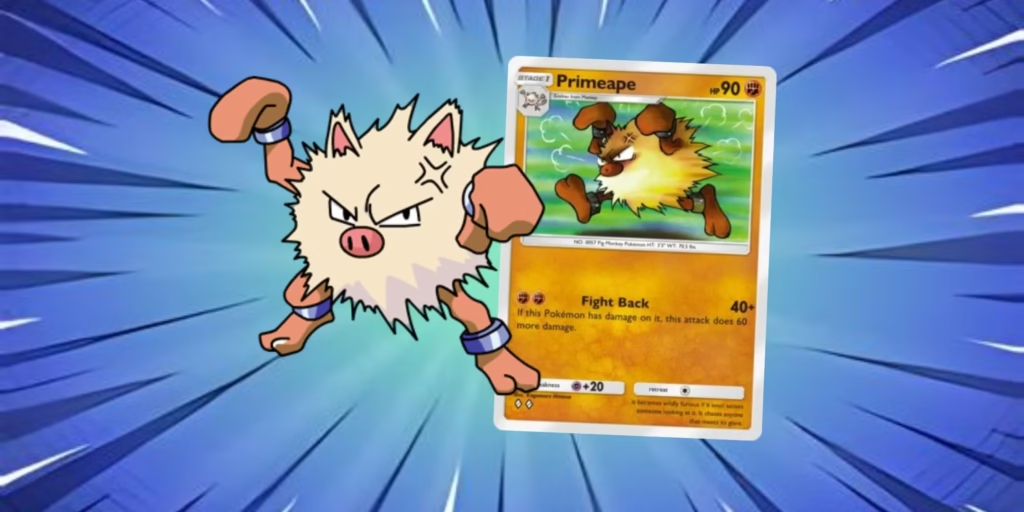Best Fighting-type cards in Pokémon TCG Pocket
Have you ever considered building a deck focused on Fighting-type cards in Pokémon TCG Pocket? It might seem strange at first, since these cards aren't always among the most used. However, ignoring this type is a common mistake. They have raw attack power, cause interesting impacts with few hits, and can still distribute damage strategically among the opponent's Pokémon.

The Pokémon TCG Pocket has a multitude of cards that allow you to create varied strategies to face your opponents. Among them, Fighting-type cards carry a concrete advantage: direct, hard, and often unpredictable blows. Below, see some that make a real difference in a duel.
Hitmonlee
Hitmonlee has a very specific function: to damage Pokémon on the bench. The Stretch Kick attack hits for 30 points with only one energy. This makes it difficult for the opposing team to assemble, especially at the beginning of the match. While your opponent is still setting up their pieces, you're already starting to wear down their defense. Among Fighting-type cards, Hitmonlee has this tactic of slowly but surely weakening the opposing side.
Machamp
Machamp doesn't need flashy effects. With its Seismic Toss attack, it deals 100 damage without needing any extra conditions. Furthermore, since it's not an EX card, losing it from the field only costs the opponent one prize. This allows for a longer, well-planned game. It's a clear example of how Fighting-type cards can hit hard without needing many surrounding resources. Just put Machamp into play and sustain the offensive.
Primeape

Primeape is a clear example of an underrated card. Its Fight Back attack doubles in strength when it has already been hit. Thus, its damage reaches 100 points with only two energies. It fits well into strategies where risk is calculated. After taking a light hit, Primeape becomes a threat. And the best part: its retreat cost is low, which facilitates quick decisions if the opponent tries to reverse the advantage. Among Fighting-type cards, Primeape gains space precisely because of this unexpected counter-attack dynamic.
Kabutops
Kabutops is straightforward. The Leech Life attack deals 50 damage and restores the same amount of health. Of course, the healing depends on the damage dealt, so any increase in the strength of this attack provides a double benefit. Thus, Kabutops has interesting staying power. It attacks and stays alive, without depending on constant external support.
Machamp Ex
Machamp ex has 180 hit points and 120 attack with only three energies. It doesn't need an effect to function. It hits hard, holds up on the field, and applies constant pressure. Among Fighting-type cards, Machamp ex is one of the most impactful. When knocked out, it has already dealt enough damage to give an advantage in the duel.
Golem

Golem doesn't hold back when it comes to hitting. The Double-Edge attack hits for 150 points, but Golem itself takes 50 damage. It's the kind of card you hold at the right moment to make a decisive impact. Sure, the energy cost is high, but if you have ways to speed it up, like support cards, the effect can be overwhelming.
Marowak Ex
Marowak ex relies on luck. The Bonemerang attack depends on two coin flips, and each "heads" deals 80 damage . Thus, it can reach 160 damage. Although luck is a factor, the energy cost isn't that high. With 140 hit points, Marowak ex has reasonable resistance. Therefore, Marowak ex also fits well as a surprise card in Fighting-type decks.
Grapploct

Grapploct's Knock Back attack forces the opponent to switch out their Active Pokémon , which seems simple, but can throw the opponent's entire plan off balance. Especially at the beginning of the match, when the other side doesn't yet have everything ready, this forced switch opens up opportunities for mistakes and mistakes.
Finally, when building a deck focused on this type of attack, think about energy distribution. Since many attacks require three or more energy, it's good to have support cards that help with this. It's interesting to vary between cards that deal direct damage and those that disrupt the enemy bench. Finally, it's also worth considering retreat points. Many of these cards have a low cost to leave the field. Use this to your advantage in critical moments.













